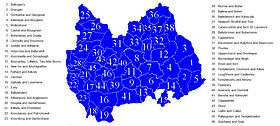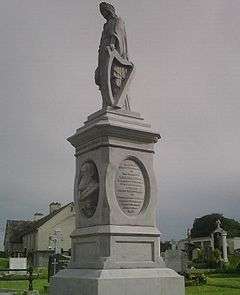Kilteely-Dromkeen
| Kilteely - Dromkeen Cill Tíle - Drom Caoin | |
|---|---|
| Town | |
 Kilteely - Dromkeen Location in Ireland | |
| Coordinates: 52°33′14″N 8°23′29″W / 52.55402°N 8.391495°WCoordinates: 52°33′14″N 8°23′29″W / 52.55402°N 8.391495°W | |
| Country | Ireland |
| Province | Munster |
| County | County Limerick |
| Government | |
| • Dáil Éireann | Limerick East |
| Time zone | WET (UTC+0) |
| • Summer (DST) | IST (WEST) (UTC+1) |
| Area code(s) | 061-38**** |
| Irish Grid Reference | R726413IrishGrid |
Kilteely and Dromkeen is an ecclesiastical parish in the Roman Catholic Archdiocese of Cashel and Emly that is located in eastern County Limerick, Ireland. The southern part of the parish is centred on the village of Kilteely (Irish: Cill Tíle or "The Church of Tidel") which is located at the foot of the Hill of Kilteely, about 14 miles south-east of the city of Limerick. It is also a civil parish in the ancient barony of Smallcounty. The northern part of the parish is centred on the village of Dromkeen (Irish: Drom Caoin or "The Smooth Ridge") which is located on the N24 Limerick- Waterford Road, halfway between Limerick City and Tipperary town. It is also a civil parish in the barony of Clanwilliam.
Geography
The landscape in this parish is different from the rest of the landscape in County Limerick which is predominantly flat. This is because Kilteely-Dromkeen is situated in one of the most important Carboniferous Volcanic districts in either Great Britain or Ireland. A variety of igneous rocks from two volcanic phases of about 300 million years ago can be found here. The volcanic plugs of Knockderk 220 m (782 ft) and Kilteely Hill 176 m (580 ft) are both conical in appearance, while in the neighbouring parish of Pallasgreen stands the Hill of Nicker, where hardened lavas have formed a cliff of basalt hexagons, similar to those found at the Giant's Causeway. As the area is within the Golden Vale, the land in this area is generally good, and is used primarily for the grazing of livestock and some tillage. The Mulkear River flows through the eastern edges of Dromkeen parish.
History


Dromkeen is famous for the Dromkeen Ambush, an attack on Black and Tan police forces during the Irish War of Independence in 1921. The attack was carried out near the old Church of Ireland church in a joint operation between the East Limerick and West Limerick Brigades of the Irish Republican Army (IRA). A flying column force of about 40 ambushed two lorries carrying between them thirteen Black and Tan police officers. Two of these managed to escape, but the other eleven were killed. It was one of the larger operations carried out by the IRA during the War of Independence; the IRA had been expecting a larger police force.
In modern times, Dromkeen was well known for its ballroom of romance, "The Oyster Ballroom",[1] owned by the Hayes family. Since its creation in 1958 through the 60s it enjoyed immense popularity and attracted large crowds – sometimes up to 2,000 dancers from counties Limerick and Tipperary – for the weekly Sunday night dance where the leading showbands of the day played on a regular basis.
Education
The parish is served by two primary schools; Kilteely National School is located in Kilteely village, Cloverfield National School is located in Dromkeen parish.
Sport
There is a strong Gaelic Athletic Association (GAA) following in the area. Teams from Kilteely-Dromkeen GAA Club compete in the East Limerick Division at Junior and under-age competitions in hurling and Gaelic football. Kilteely AFC soccer club was founded in 1983 and plays in the Limerick city and county leagues.
People

- Joseph Bradshaw, Victoria Cross recipient
- Willie O'Dea (born November 27, 1952) - Fianna Fáil T.D. for Limerick East and Minister for Defence.
- John Francis Dillon (born July 24, 1930 - died August 18, 1952) - Killed in the Korean War.
- William Lundon (born 1839 - died March 24, 1909) - Irish Parliamentary Party M.P. for East Limerick.
Transport
- Dromkeen railway station opened on 2 February 1851, closed for goods traffic on 9 September 1963, and finally closed altogether on 6 September 1976.[2]
See also
References
- ↑ "Oyster Ballroom Dromkeen". www.irish-showbands.com. Retrieved 2007-11-28.
- ↑ "Dromkeen station" (PDF). Railscot - Irish Railways. Retrieved 2007-10-12.